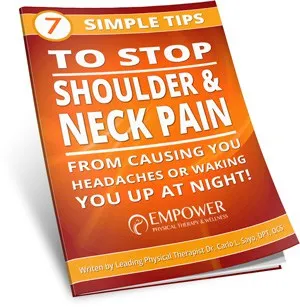Chino Hills, CA– About 8 years ago, I was working with a woman with headaches, and I learned a valuable lesson. This 43 year old woman (let’s call her Kathy) had what looked like pretty straight forward “tension” headaches. Your suboccipital muscles run from the base of your skull to the upper portion of your neck and tension on these muscles can be quite painful, and they can often cause headaches when they start to compress the nerves that run through them.
Back to Kathy’s story…
During her treatment sessions, I focused on deep tissue massage to Kathy’s subocciptal muscles, and I also included some traction and mobilization techniques to loosen up the joints. Kathy was also working with a chiropractor, so between the two of us, Kathy should’ve been feeling pretty good. Unfortunately, after 2-3 weeks of treatment, she really wasn’t feeling much better.
Kathy was also seeing a local pain management doctor who was considering giving her injections. As you can imagine, she was very apprehensive about getting shots. During the course of pursuing injections, Kathy also saw another one of our physical therapists, who uncovered what I had been missing: Kathy had a problem with her shoulder.
What I didn’t tell you about Kathy is that she was a music teacher at a local high school. Her job included a lot of repetitive use of her right arm. And during the course of her repetitive use, she had really irritated her “rotator cuff” muscles in her right shoulder. It was this shoulder pain that was causing her neck pain and headaches. Let me explain…
The shoulder is a fairly complex joint, and there are actually 4 joints involved with shoulder movements. I won’t go into too much detail here, but the ball and socket joint of the shoulder is directly tied to the neck via several muscles that extend from the shoulder blade to various regions of the neck and upper back. When the shoulder gets irritated (especially the rotator cuff muscles), the mechanics of the whole shoulder complex start to change. In Kathy’s case, several of the muscles that attach her shoulder blade to her neck were starting to work overtime to compensate for the irritated rotator cuff muscles. This resulted in increased tension surrounding her neck and suboccipital muscles, thereby causing her neck pain and headaches.
Key Points
Key point #1
In Kathy’s case, her shoulder was the ROOT CAUSE of her neck pain and headaches. Like I mentioned, I learned a very important lesson that day. I thought that the neck muscles were the root cause of Kathy’s headaches, but in reality her irritated shoulder was the root cause of the tension in the suboccipital muscles. Once I started to focus on reducing the irritation in Kathy’s rotator cuff muscles (followed by strengthening them), she started to improve much more quickly and was able to avoid needing injections.
Key Point #2
I could have continued treating Kathy’s suboccipital muscles for several more weeks without much result, and we never would’ve gotten any further than temporary pain relief. In order to progress beyond temporary relief, you must uncover the root cause of the pain.
So that’s my message for this week. A friend of mine likes to say that “Small hinges swing big doors.” In Kathy’s case, we were just missing one piece to the puzzle (a very important piece), and once we found it, we were finally able to get rid of her neck pain and headaches for good.
If you find yourself in a similar position as Kathy, trying your best to get rid of your neck pain and/or headaches but can’t seem to get on top of the pain, it might be something as simple for you as well, so don’t give up!
If you have any questions about neck pain and headaches you can ask Dr. Carlo and he will be happy to answer them – please phone at (909) 907-0805 or email Carlo@empowerPTwellness.com or if you would like some simple tips to relieve neck and shoulder pain, click the button below to request a free guide.



